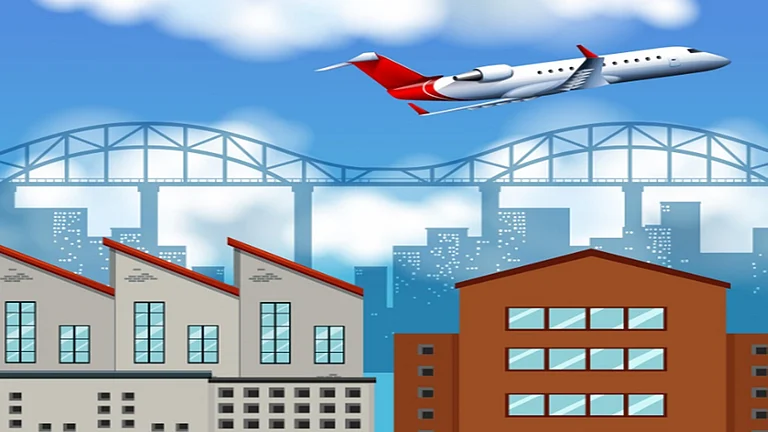In the recent week, Noida's real estate sector has been jolted by the Gautam Budh Nagar district administration's directive prohibiting all construction within a 10-km radius of the upcoming Noida International Airport—unless a formal No Objection Certificate (NOC) is secured from the concerned authority. This also applies to activities as granular as tree plantations, drone operations, and laser installations. Additionally, within the 10–20 km buffer zone, height clearances from the Airports Authority of India (AAI) through the NOCAS portal are now mandatory.
"While this might appear to be a sudden crackdown, it's anything but unusual in global real estate. I see this not as a challenge—but as India's opportunity to align with global aviation-led development protocols," says Sam Chopra, President & CEO, eXp India.
Learning From The World: Global Airports, Local Lessons
From Hong Kong to Warsaw, Taiwan to Heathrow, airports have long operated with protective development corridors. These aren't bureaucratic speed bumps—they are strategic safeguards.
In Hong Kong, after the old Kai Tak airport was shut down and operations moved to Chek Lap Kok, property prices in the surrounding areas soared by over 24 per cent - noise reduction alone transformed buyer sentiment.
"In Taiwan, homes exposed to high levels of airport noise lose as much as USD 2,300–3,600 per decibel. In Poland, homes near Warsaw Chopin Airport's "limited-use zones" sell at a 14 per cent discount. Even in the UK, Heathrow's expansion saw 700 homes acquired and demolished, but with thoughtfully structured compensation packages to protect resident trust and asset value," Chopra says, adding, "What all these cases teach us is this: short-term discomfort due to regulation is almost always rewarded by long-term appreciation and improved quality of urbanisation."
Goa: How Mopa Airport Is Reshaping Coastal Real Estate
In the case of India, for example, the opening of Mopa International Airport in January 2023 has quietly triggered a coastal real estate boom. North Goa and the Konkan belt are experiencing property price hikes of 25–30 per cent year-on-year, with rental yields reaching up to 7 per cent for premium second homes and villas./
What's interesting is that Mopa, like Jewar, sits outside traditional urban cores—but well-planned airport-led growth has turned it into a magnet for NRI investors, HNIs, and urban migrants seeking lifestyle upgrades.
Noida Airport's 10 Km Ban: Impact On Real Estate & Homebuyers
According to industry experts, this move, though disruptive for some in the short term, is part of a larger transformation.
"It aligns with how Singapore built Changi, how Doha planned Hamad, and how Vancouver enforced height buffers for urban consistency. If managed well, the 10–20 km zone around Noida International Airport could become NCR's most-coveted investment corridor—clean, compliant, well-zoned, and future-proof," observes Chopra.
Viineet Chellani, Founder, Asset Deals, says, "For prospective buyers, this directive may actually work in their favour. With approvals slowing briefly, end-users may have a window to enter the market more confidently. However, once the clearance process is streamlined, demand is expected to bounce back, and so will prices. For serious buyers, it's a good time to assess opportunities, especially in projects with all the right approvals in place. Over the long run, the airport's development will only push property values upward in the region."
Developers say the current directive serves as a standard regulatory procedure that often occurs in areas adjacent to aviation. It targets illegal construction activities that endanger aircraft's operational safety.
"Real estate developers are fully aware of these procedures, which guide their planning of projects that must consider airport proximity height restrictions. The approval delays caused by this directive will not create any sustained interference with market operations. The situation serves as a reminder for buyers to check project approvals and obtain all required NOCs before buying properties. Such inspections help protect buyer interests because they establish both compliance standards and transparency measures. The NCR markets, including Noida, continue to maintain their strong fundamentals, and no price fluctuations are expected because of these developments," says Sahil Agarwal, CEO, Nimbus Realty.
Deepak Kapoor, Director, Gulshan Group, says proximity to airports places certain restrictions on construction activities and requires mandatory clearances from the authorities to ensure safe flying operations. It's a routine process, and real estate developers are aware of the protocol and the resultant height restrictions depending upon the distance from the airport.
"Moreover, the present order is more geared towards banning illegal construction that does not possess a mandatory NOC. As a result, this move will benefit buyers and the real estate sector. It is always advisable for the buyers to check the project's mandatory approvals. However, in case of a property within 10 km of the Noida International Airport, one must also verify the relevant NOC permitting construction from the administrative department," Kapoor adds.
According to property consultants, the recently-imposed restrictions are not a ban on development, but rather a regulatory safeguard requiring mandatory No Objection Certificates (NOCs) from the concerned authorities, primarily based on height limitations and proximity to the airport.
Nonetheless, "while the height restriction may influence the design and scale of the projects, it may not restrict the development of the projects. Hence, the ongoing projects and proposed development in the area may not have a long-lasting impact. Additionally, as a buyer it is necessary to practice complete due diligence of the projects one is planning to invest into, which may include ensuring that there is necessary NOC from relevant authorities, and understanding that the building restrictions are as per permissible rules and specified under the Colour Coded Zoning Map (CCZM)," says Swapnil Anil, Managing Director-Advisory Services, Colliers India.














